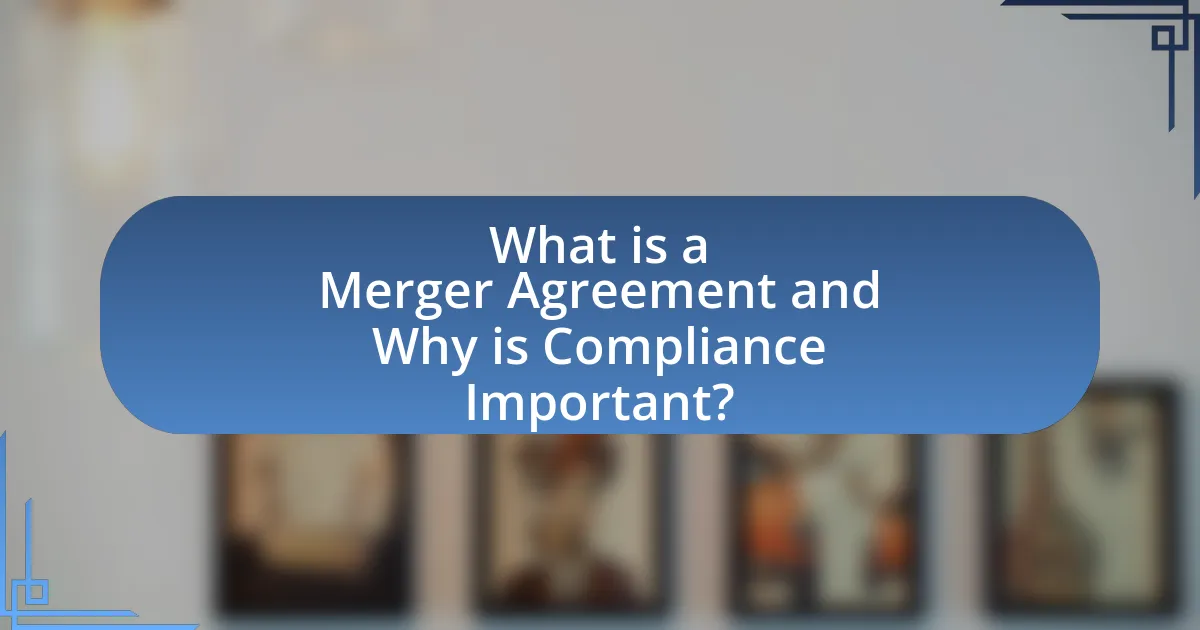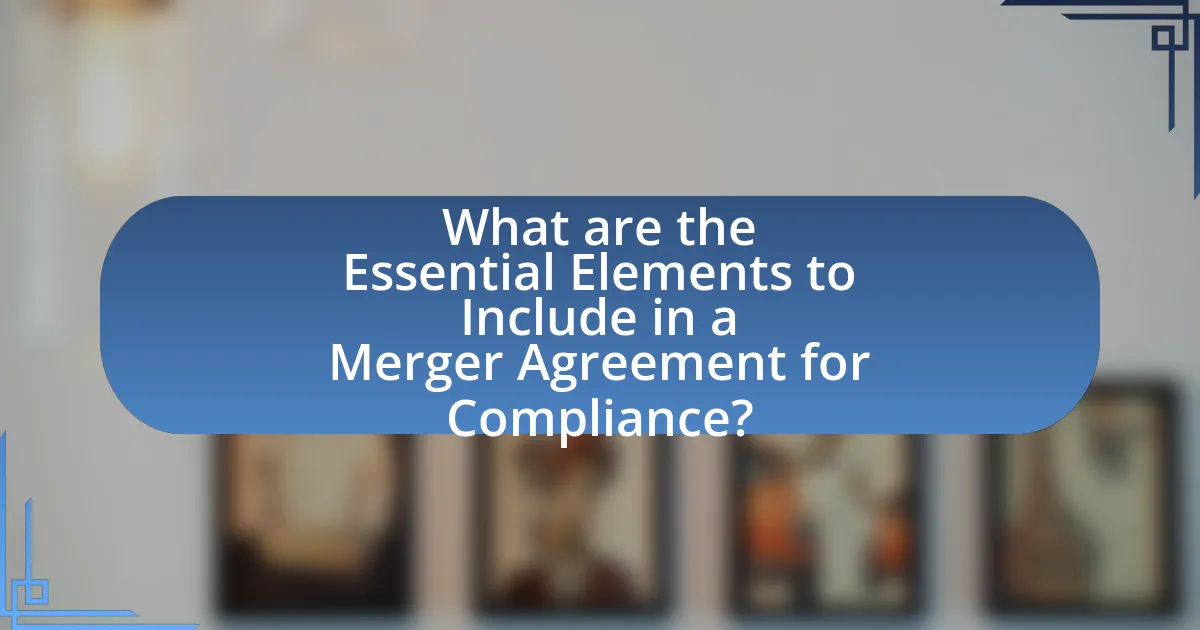A merger agreement is a legally binding document that outlines the terms and conditions for the combination of two companies. Compliance with this agreement is essential to ensure adherence to financial obligations, regulatory approvals, and operational integration processes, as non-compliance can lead to legal disputes and financial penalties. The article details the key components of a merger agreement, including representations and warranties, covenants, and conditions to closing, which collectively ensure compliance with legal standards. It also discusses the potential risks of non-compliance, the importance of thorough due diligence, and best practices for structuring agreements to mitigate risks and enhance the likelihood of a successful merger.

What is a Merger Agreement and Why is Compliance Important?
A merger agreement is a legally binding document that outlines the terms and conditions under which two companies agree to combine their operations. Compliance with this agreement is crucial because it ensures that both parties adhere to the stipulated terms, which can include financial obligations, regulatory approvals, and operational integration processes. Non-compliance can lead to legal disputes, financial penalties, and the potential failure of the merger, as evidenced by cases where companies faced significant losses due to breaches of merger agreements.
How does a merger agreement function in business transactions?
A merger agreement functions as a legally binding document that outlines the terms and conditions under which two or more companies agree to combine their operations. This agreement specifies the structure of the merger, including the valuation of the companies, the exchange ratio of shares, and the responsibilities of each party involved. It serves to protect the interests of both parties by detailing the rights and obligations, including any regulatory compliance requirements that must be met for the merger to proceed. For instance, according to the Securities and Exchange Commission, merger agreements must comply with federal securities laws, ensuring transparency and fairness in the transaction.
What are the key components of a merger agreement?
The key components of a merger agreement include the terms of the merger, representations and warranties, covenants, conditions to closing, and indemnification provisions. The terms of the merger outline the structure and mechanics of the transaction, while representations and warranties provide assurances about the accuracy of information shared by the parties. Covenants detail the obligations of each party before and after the merger, and conditions to closing specify the requirements that must be met for the merger to proceed. Indemnification provisions protect parties from losses arising from breaches of the agreement. These components are essential for ensuring clarity and compliance in the merger process.
How do these components ensure compliance with legal standards?
The components of a merger agreement ensure compliance with legal standards by incorporating specific clauses that adhere to regulatory requirements. These clauses include representations and warranties, which confirm that both parties are legally compliant and disclose any potential liabilities. Additionally, the agreement outlines the necessary approvals from regulatory bodies, ensuring that all legal obligations are met before the merger is finalized. For instance, compliance with antitrust laws is often addressed through provisions that require the parties to obtain clearance from competition authorities, thereby preventing legal challenges post-merger.
What are the potential risks of non-compliance in merger agreements?
Non-compliance in merger agreements can lead to significant legal and financial risks. These risks include potential lawsuits from shareholders or regulatory bodies, which can result in costly litigation and penalties. Additionally, non-compliance may lead to the annulment of the merger, causing financial losses and reputational damage to the involved companies. For instance, the Federal Trade Commission has the authority to block mergers that violate antitrust laws, illustrating the regulatory risks associated with non-compliance. Furthermore, failure to meet contractual obligations can result in breach of contract claims, which may require compensation for damages incurred by the other party.
What legal consequences can arise from non-compliance?
Non-compliance can lead to significant legal consequences, including fines, penalties, and potential litigation. Regulatory bodies may impose financial penalties for failing to adhere to laws and regulations, which can vary in severity based on the nature of the non-compliance. Additionally, affected parties may pursue legal action, resulting in costly lawsuits and damages. For instance, the Sarbanes-Oxley Act imposes strict compliance requirements on publicly traded companies, and violations can lead to fines up to $5 million and imprisonment for executives. Thus, the legal ramifications of non-compliance can be both financially burdensome and damaging to a company’s reputation.
How can non-compliance affect the merger’s success?
Non-compliance can significantly undermine a merger’s success by leading to legal penalties, operational disruptions, and loss of stakeholder trust. When companies fail to adhere to regulatory requirements or contractual obligations, they may face fines or litigation, which can delay or derail the merger process. For instance, the merger between AT&T and Time Warner faced scrutiny from regulators, highlighting how non-compliance with antitrust laws can jeopardize a merger’s approval. Additionally, non-compliance can create internal conflicts and misalignment between merging entities, further complicating integration efforts and diminishing overall value creation.

What are the Essential Elements to Include in a Merger Agreement for Compliance?
The essential elements to include in a merger agreement for compliance are representations and warranties, covenants, conditions precedent, and indemnification provisions. Representations and warranties ensure that both parties disclose accurate information about their financial status and operations, which is crucial for regulatory compliance. Covenants outline the obligations of each party during the merger process, ensuring adherence to legal and regulatory requirements. Conditions precedent specify the necessary approvals and conditions that must be met before the merger can be finalized, which helps in complying with legal standards. Indemnification provisions protect parties from losses arising from breaches of the agreement, reinforcing compliance with applicable laws and regulations. These elements collectively ensure that the merger adheres to legal standards and minimizes risks associated with non-compliance.
How should the terms and conditions be structured?
Terms and conditions should be structured clearly and logically to ensure compliance in a merger agreement. The structure typically includes sections such as definitions, obligations of the parties, representations and warranties, covenants, conditions precedent, termination rights, and dispute resolution mechanisms. Each section should be concise, using plain language to minimize ambiguity, and should specify the rights and responsibilities of each party involved in the merger. This clarity helps prevent misunderstandings and legal disputes, which is crucial for compliance. For instance, the inclusion of specific performance metrics and timelines can provide measurable benchmarks for compliance, thereby reinforcing the agreement’s enforceability.
What specific clauses are necessary for compliance?
Specific clauses necessary for compliance in a merger agreement include representations and warranties, covenants, conditions precedent, and indemnification provisions. Representations and warranties ensure that both parties disclose accurate information about their financial status and legal standing, which is critical for regulatory approval. Covenants outline the obligations of each party during the merger process, ensuring adherence to legal and regulatory requirements. Conditions precedent specify the necessary approvals and conditions that must be met before the merger can be finalized, which helps in compliance with applicable laws. Indemnification provisions protect parties from losses arising from breaches of the agreement, reinforcing accountability and compliance with legal standards.
How do these clauses protect both parties involved?
Clauses in a merger agreement protect both parties by clearly defining rights, obligations, and remedies, thereby minimizing risks and misunderstandings. For instance, confidentiality clauses safeguard sensitive information from being disclosed, ensuring that proprietary data remains secure for both entities. Indemnification clauses provide financial protection by outlining responsibilities for losses or damages, which can arise from breaches of the agreement. Additionally, representations and warranties clauses ensure that both parties disclose accurate information about their financial and operational status, reducing the likelihood of disputes post-merger. These mechanisms collectively foster trust and accountability, essential for a successful merger.
What role do representations and warranties play in compliance?
Representations and warranties serve as critical components in ensuring compliance within merger agreements. They provide assurances from the seller regarding the accuracy of information and the legal standing of the business being acquired, which helps the buyer assess risks and make informed decisions. For instance, representations may include statements about the company’s financial condition, compliance with laws, and ownership of assets. These assurances are essential because they establish a basis for accountability; if a representation is found to be false, the buyer may have grounds for legal recourse, including claims for damages or contract termination. This framework not only protects the buyer but also incentivizes the seller to maintain transparency and adhere to legal standards, thereby fostering overall compliance in the transaction.
What are common representations and warranties included?
Common representations and warranties included in merger agreements typically encompass the accuracy of financial statements, compliance with laws, ownership of assets, and the absence of undisclosed liabilities. These elements ensure that the parties involved have a clear understanding of the business’s legal and financial standing. For instance, the representation regarding the accuracy of financial statements confirms that the provided financial data is true and reflects the company’s actual performance, which is crucial for informed decision-making during the merger process.
How do these elements mitigate risks during the merger process?
Elements such as thorough due diligence, clear communication, and well-defined roles mitigate risks during the merger process by identifying potential issues early, ensuring alignment between merging entities, and establishing accountability. Thorough due diligence uncovers financial, legal, and operational risks, allowing for informed decision-making and risk management strategies. Clear communication fosters transparency and trust, reducing misunderstandings that could lead to conflicts. Well-defined roles clarify responsibilities, minimizing overlap and ensuring that all parties are aware of their obligations, which helps streamline integration and maintain operational continuity. These practices collectively enhance the likelihood of a successful merger by addressing risks proactively.

How to Ensure Compliance Throughout the Merger Process?
To ensure compliance throughout the merger process, organizations must implement a comprehensive compliance framework that includes due diligence, regulatory assessments, and integration planning. This framework should begin with thorough due diligence to identify any legal, financial, or operational risks associated with the merger, ensuring that all relevant laws and regulations are understood and adhered to. Regulatory assessments must be conducted to evaluate the merger’s impact on competition and compliance with antitrust laws, as evidenced by the Federal Trade Commission’s guidelines on merger reviews. Additionally, integration planning should include the establishment of compliance protocols and training programs for employees to align corporate cultures and operational practices, thereby minimizing the risk of non-compliance post-merger.
What steps should be taken during due diligence?
During due diligence, the primary steps include identifying key areas of investigation, gathering relevant documents, conducting interviews, and analyzing financial statements. Identifying key areas involves focusing on legal, financial, operational, and compliance aspects of the target company. Gathering relevant documents entails collecting contracts, corporate records, and regulatory filings to assess liabilities and obligations. Conducting interviews with management and key personnel provides insights into operational practices and potential risks. Analyzing financial statements helps in evaluating the financial health and performance of the target company. These steps are essential to ensure a comprehensive understanding of the target’s position and to mitigate risks associated with the merger.
How can thorough due diligence prevent compliance issues?
Thorough due diligence can prevent compliance issues by identifying potential legal and regulatory risks before they escalate. By conducting comprehensive assessments of financial records, operational practices, and legal obligations, organizations can uncover discrepancies or non-compliance that may lead to penalties or legal action. For instance, a study by the Association of Certified Fraud Examiners found that organizations that implement rigorous due diligence processes reduce the likelihood of compliance violations by up to 50%. This proactive approach allows companies to address issues early, ensuring adherence to laws and regulations, thereby safeguarding their reputation and financial stability.
What documentation is essential during due diligence?
Essential documentation during due diligence includes financial statements, tax returns, legal contracts, corporate governance documents, and compliance records. Financial statements provide insights into the company’s financial health, while tax returns verify tax compliance and liabilities. Legal contracts outline obligations and rights, and corporate governance documents reveal the structure and policies of the organization. Compliance records ensure adherence to regulations and standards. Collectively, these documents facilitate a comprehensive assessment of risks and opportunities, which is crucial for informed decision-making in merger agreements.
How can legal counsel assist in ensuring compliance?
Legal counsel assists in ensuring compliance by providing expert guidance on applicable laws and regulations relevant to mergers. They analyze the legal framework governing the merger, identify potential compliance risks, and recommend strategies to mitigate those risks. For instance, legal counsel can draft and review merger agreements to ensure they align with antitrust laws and securities regulations, thereby preventing legal disputes and penalties. Their expertise in regulatory requirements helps organizations navigate complex compliance landscapes, ensuring that all necessary filings and disclosures are completed accurately and timely.
What are the benefits of involving legal experts early in the process?
Involving legal experts early in the process of structuring a merger agreement ensures compliance and mitigates risks. Legal experts provide essential guidance on regulatory requirements, helping to identify potential legal issues before they escalate. Their involvement can lead to more efficient negotiations, as they can clarify legal terms and conditions, ensuring that all parties understand their obligations. Additionally, early legal input can enhance the overall quality of the merger agreement, reducing the likelihood of disputes and facilitating smoother integration post-merger.
How can legal counsel help in drafting compliant agreements?
Legal counsel assists in drafting compliant agreements by ensuring that all terms adhere to applicable laws and regulations. They analyze the legal framework relevant to the merger, identify potential compliance issues, and incorporate necessary provisions to mitigate risks. For instance, legal counsel can reference the Sarbanes-Oxley Act, which mandates specific disclosures in merger agreements, ensuring that the document meets federal requirements. By leveraging their expertise, legal counsel helps to create agreements that not only protect the interests of the parties involved but also comply with legal standards, thereby reducing the likelihood of disputes or regulatory penalties.
What best practices should be followed for compliance in merger agreements?
Best practices for compliance in merger agreements include conducting thorough due diligence, ensuring clear and precise language in the agreement, and adhering to regulatory requirements. Conducting due diligence allows parties to identify potential legal and financial risks, which is essential for compliance. Clear language minimizes ambiguity, reducing the likelihood of disputes and ensuring all parties understand their obligations. Adhering to regulatory requirements, such as antitrust laws and securities regulations, is critical to avoid legal penalties and ensure the merger is approved by relevant authorities. These practices are supported by the fact that mergers often face scrutiny from regulatory bodies, making compliance essential for successful integration.
How can regular compliance audits be implemented?
Regular compliance audits can be implemented by establishing a structured audit schedule, defining clear compliance criteria, and assigning dedicated personnel to oversee the process. Organizations should create a compliance audit framework that includes specific timelines, methodologies, and reporting mechanisms to ensure thorough evaluations. For instance, the Sarbanes-Oxley Act mandates regular audits for publicly traded companies, highlighting the importance of compliance in financial reporting. By adhering to such regulatory requirements, organizations can ensure that their compliance audits are not only systematic but also aligned with legal standards.
What are the common pitfalls to avoid in merger agreements?
Common pitfalls to avoid in merger agreements include inadequate due diligence, poorly defined terms, and lack of clear communication. Inadequate due diligence can lead to unforeseen liabilities or operational challenges post-merger, as evidenced by the failure of the merger between AOL and Time Warner, where undisclosed financial issues contributed to significant losses. Poorly defined terms can result in ambiguity regarding roles, responsibilities, and expectations, which can create conflicts and hinder integration efforts. Lastly, lack of clear communication among stakeholders can lead to misunderstandings and resistance to change, as seen in various mergers where employee morale and retention suffered due to uncertainty. Addressing these pitfalls is crucial for a successful merger.


